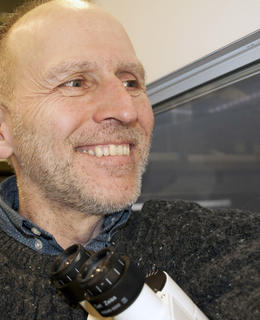
Dr. Matthias Walter Amrein
Positions
Professor
Cumming School of Medicine, Department of Cell Biology and Anatomy
Member
Arnie Charbonneau Cancer Institute
Full Member
The Calvin, Phoebe and Joan Snyder Institute for Chronic Diseases
Contact information
Web presence
Phone number
Office: 403.210.8177
Location
Office: HSCB129
Preferred method of communication
Admin Assistant
Tiziana Reiter
Email: cyron@ucalgary.ca
Office: 403.210.6766
Background
Educational Background
B.S. Medicine, Swiss Federal Inst Technology, 1985
Doctor of Habilitation Medicine, Munster (Westfalische Wilhelm), 1998
Doctor of Philosophy Other Basic Sciences, Swiss Federal Inst Technology, 1989
Biography
Dr. Amrein is a researcher at the Cumming School of Medicine, University of Calgary, Snyder Institute for Chronic Diseases, Airway Inflammation Research Group (AIRG). He studied at the Swiss Federal Institute of Technology, Zurich (ETH) with a doctorate from a joint venture between the IBM research lab in Rueschlikon (group of Nobel Laureate Heinrich Rohrer) and ETH, where he was the first to successfully apply the then new scanning probe technique (STM, AFM) to the biomedical area. As the director of a university-wide microscopy and imaging facility (MIF), I have unique insight and experience in how to apply leading microscopy techniques to medical research, including cancer research. The facility offers electron-, atomic force- and super resolution light microscopy and serves researchers from more than 100 industry- and academic labs from medicine, biological sciences and engineering microscopy. Within the MIF, we have invented some of the methods offered, including single cell force spectroscopy as a cell activation tool (see next section). This patented method was discussed in the editorial of Science and has led to publications in Nature Medicine, Immunity, Journal of Experimental Medicine, etc. Another recent discovery by the Amrein lab together with the group of Dr. Garnette Sutherland concerns cancer tissues vibrations with a potential for real-time cancer diagnostics on biopsies and potentially within the body (see next section). The method for recording these vibrations and the respective analysis of the signal were developed in the Amrein lab and may be applicable to to study how cancer cells respond to immune cells, for example, or to contact with an exosome.
Research
Areas of Research
In his current function as a member of the AIRG he credits his group with discovering the main mechanism of pulmonary surfactant dysfunction with a treatment in pre-clinical testing and patents recently granted (Matthias W. Amrein, Lasantha C. Gunasekara, Ryan Pratt Treatment of pulmonary surfactant dysfunction using cholesterol-sequestering cyclodextrins, EP 2900246 A4, CA 2886544 A1, WO2014047715A1, Matthias W. Amrein, Lasantha C. Gunasekara, Ryan Pratt Method of treating pulmonary surfactant dysfunction or respiratory distress syndrome by administering cyclodextrin or a derivative thereof US9545424 B2). The patent is licensed to a pharmaceutical startup (SolAreoMed, Calgary) for who Dr. Amrein acts as an advisor.
His group studies the interaction of nanoparticles with the lung’s walls, where they now found a mechanism of alveolar epithelial cells efficiently take up and clear nanoparticles. This project employs a host of microscopy techniques some of which were invented or developed by Amrein and co-workers: a novel technique of intravital lung microscopy, developed by us; single cell force spectroscopy as a cell activation tool (MW. Amrein and Y. Shi METHOD AND APPARATUS FOR DETERMINING THE CELL ACTIVATION OF A TARGET CELL BY AN ACTIVATOR US Patent 9,018,018, 2015); electron microscopy, electron tomography, live cell confocal imaging and super resolution light microscopy. A respective publication is currently under revision in Nature Nanotechnology.
Another recent contribution, the Amrein lab together with the group of Dr. Garnette Sutherland discovered that cancer tissues vibrate with a tissue-specific pattern of frequencies. The method for recording these vibrations and the respective analysis of the signal were developed in the Amrein lab (Theranostics 7(9): 2417-2430, Amrein is a corresponding author). We now use optical tweezers to study the detailed vibrational profiles of cancer cells as well as how cancer cells interact with their environment.
Are you the profile owner?
Login to edit.

